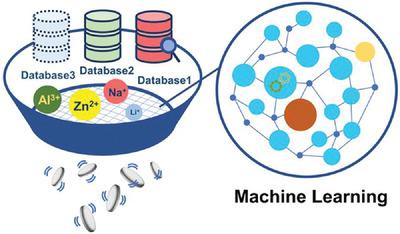当前位置:
X-MOL 学术
›
Adv. Theory Simul.
›
论文详情
Our official English website, www.x-mol.net, welcomes your
feedback! (Note: you will need to create a separate account there.)
Machine Learning Assisted Prediction of Cathode Materials for Zn-Ion Batteries
Advanced Theory and Simulations ( IF 2.9 ) Pub Date : 2021-08-11 , DOI: 10.1002/adts.202100196 Linming Zhou 1 , Archie Mingze Yao 2 , Yongjun Wu 1, 3 , Ziyi Hu 1 , Yuhui Huang 1 , Zijian Hong 1, 3
Advanced Theory and Simulations ( IF 2.9 ) Pub Date : 2021-08-11 , DOI: 10.1002/adts.202100196 Linming Zhou 1 , Archie Mingze Yao 2 , Yongjun Wu 1, 3 , Ziyi Hu 1 , Yuhui Huang 1 , Zijian Hong 1, 3
Affiliation

|
Rechargeable Zn batteries with aqueous electrolytes have been considered as promising alternative energy storage technology, with various advantages such as low cost, high volumetric capacity, environmentally friendly, and high safety. However, a lack of reliable cathode materials has largely pledged their applications. Herein, a machine learning (ML)-based approach to predict cathodes with high capacity (>100 mAh g−1) and high voltage (>0.5 V) is developed. Over ≈130 000 inorganic materials from the materials project database are screened and the crystal graph convolutional neural network based ML approach is applied with data from the AFLOW database, the combination of these two gives rise to ≈80 predicted cathode materials. Among them, ≈10 cathode materials have been experimentally discovered previously, which agrees remarkably well with experimental measurements, while ≈70 new promising candidates have been predicted for further experimental validations. The authors hope this study could spur further interests in ML-based advanced theoretical tools for battery materials discovery.
中文翻译:

锌离子电池正极材料的机器学习辅助预测
具有水电解质的可充电锌电池被认为是有前景的替代储能技术,具有成本低、体积容量大、环境友好和安全性高等优点。然而,缺乏可靠的正极材料在很大程度上保证了它们的应用。在此,一种基于机器学习 (ML) 的方法来预测具有高容量 (>100 mAh g -1) 和高电压 (>0.5 V) 产生。从材料项目数据库中筛选出 ≈130 000 多种无机材料,并将基于晶体图卷积神经网络的 ML 方法应用于 AFLOW 数据库中的数据,这两者的结合产生了 ≈80 种预测的正极材料。其中,之前已经通过实验发现了大约 10 种正极材料,这与实验测量结果非常吻合,同时还预测了大约 70 种新的有希望的候选材料以进行进一步的实验验证。作者希望这项研究能够激发人们对基于 ML 的用于电池材料发现的先进理论工具的进一步兴趣。
更新日期:2021-09-07
中文翻译:

锌离子电池正极材料的机器学习辅助预测
具有水电解质的可充电锌电池被认为是有前景的替代储能技术,具有成本低、体积容量大、环境友好和安全性高等优点。然而,缺乏可靠的正极材料在很大程度上保证了它们的应用。在此,一种基于机器学习 (ML) 的方法来预测具有高容量 (>100 mAh g -1) 和高电压 (>0.5 V) 产生。从材料项目数据库中筛选出 ≈130 000 多种无机材料,并将基于晶体图卷积神经网络的 ML 方法应用于 AFLOW 数据库中的数据,这两者的结合产生了 ≈80 种预测的正极材料。其中,之前已经通过实验发现了大约 10 种正极材料,这与实验测量结果非常吻合,同时还预测了大约 70 种新的有希望的候选材料以进行进一步的实验验证。作者希望这项研究能够激发人们对基于 ML 的用于电池材料发现的先进理论工具的进一步兴趣。











































 京公网安备 11010802027423号
京公网安备 11010802027423号